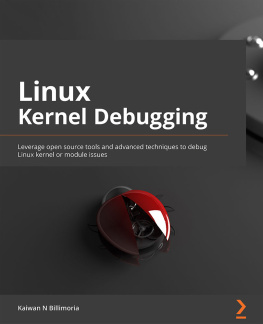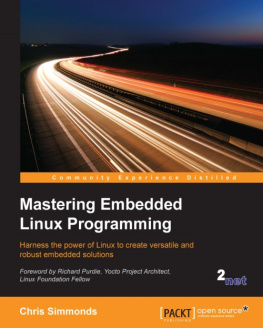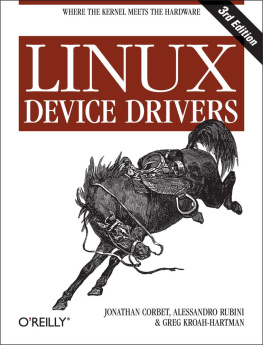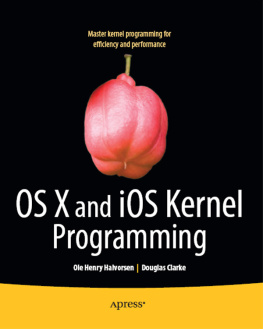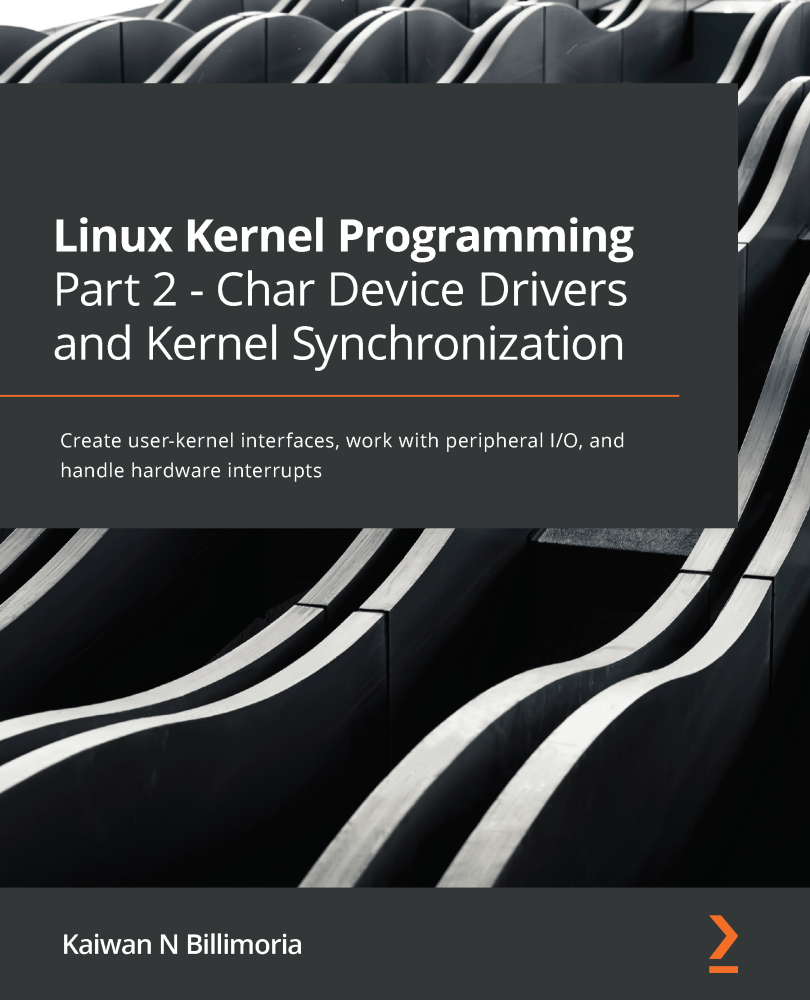
Linux Kernel Programming Part 2 - Char Device Drivers and Kernel Synchronization
Create user-kernel interfaces, work with peripheral I/O, and handle hardware interrupts
Kaiwan N Billimoria

BIRMINGHAM - MUMBAI
Linux Kernel Programming Part 2 - Char Device Drivers and Kernel Synchronization
Copyright 2021 Packt Publishing
All rights reserved. No part of this book may be reproduced, stored in a retrieval system, or transmitted in any form or by any means, without the prior written permission of the publisher, except in the case of brief quotations embedded in critical articles or reviews.
Every effort has been made in the preparation of this book to ensure the accuracy of the information presented. However, the information contained in this book is sold without warranty, either express or implied. Neither the author, nor Packt Publishing or its dealers and distributors, will be held liable for any damages caused or alleged to have been caused directly or indirectly by this book.
Packt Publishing has endeavored to provide trademark information about all of the companies and products mentioned in this book by the appropriate use of capitals. However, Packt Publishing cannot guarantee the accuracy of this information.
Group Product Manager: Wilson D'souza
Publishing Product Manager: Vijin Boricha
Content Development Editor: Romy Dias
Senior Editor: Rahul D'souza
Technical Editor: Shruthi Shetty
Copy Editor: Safis Editing
Project Coordinator: Neil Dmello
Proofreader: Safis Editing
Indexer: Pratik Shirodkar
Production Designer: Shankar Kalbhor
First published: March 2021
Production reference: 1190321
Published by Packt Publishing Ltd.
Livery Place
35 Livery Street
Birmingham
B3 2PB, UK.
ISBN 978-1-80107-951-8
www.packt.com
First, to my dear parents, Diana and Nadir "Nads", for showing me how to live a happy and productive life. To my dear wife, Dilshad (an accomplished financial advisor herself), and our amazing kids, Sheroy and Danesh thanks for all your love and patience.
Kaiwan N Billimoria
Packt.com
Subscribe to our online digital library for full access to over 7,000 books and videos, as well as industry leading tools to help you plan your personal development and advance your career. For more information, please visit our website.
Why subscribe?
Spend less time learning and more time coding with practical eBooks and Videos from over 4,000 industry professionals
Improve your learning with Skill Plans built especially for you
Get a free eBook or video every month
Fully searchable for easy access to vital information
Copy and paste, print, and bookmark content
Did you know that Packt offers eBook versions of every book published, with PDF and ePub files available? You can upgrade to the eBook version at www.packt.com and as a print book customer, you are entitled to a discount on the eBook copy. Get in touch with us at customercare@packtpub.com for more details.
At www.packt.com , you can also read a collection of free technical articles, sign up for a range of free newsletters, and receive exclusive discounts and offers on Packt books and eBooks.
Contributors
About the author
Kaiwan N Billimoria taught himself BASIC programming on his dad's IBM PC back in 1983. He was programming in C and Assembly on DOS until he discovered the joys of Unix, and by around 1997, Linux!
Kaiwan has worked on many aspects of the Linux system programming stack, including Bash scripting, system programming in C, kernel internals, device drivers, and embedded Linux work. He has actively worked on several commercial/FOSS projects. His contributions include drivers to the mainline Linux OS and many smaller projects hosted on GitHub. His Linux passion feeds well into his passion for teaching these topics to engineers, which he has done for well over two decades now. He's also the author of Hands-On System Programming with Linux. It doesn't hurt that he is a recreational ultrarunner too.
Writing this book took a long while; I'd like to thank the team from Packt for their patience and skill! Carlton Borges, Romy Dias, Vijin Boricha, Rohit Rajkumar, Vivek Anantharaman, Nithin Varghese, Hemangi Lotlikar, and all the others. It was indeed a pleasure working with you.I owe a debt of gratitude to the very able technical reviewers Donald "Donnie" Tevault and Anil Kumar. They caught a lot of my mistakes and omissions and greatly helped make this book better.
About the reviewers
Donald A. Tevault, but you can call him Donnie, got involved with Linux way back in 2006 and has been working with it ever since. He holds the Linux Professional Institute Level 3 Security certification, and the GIAC Incident Handler certification. Donnie is a professional Linux trainer, and thanks to the magic of the internet, teaches Linux classes literally the world over from the comfort of his living room. He's also a Linux security researcher for an IoT security company.
Anil Kumar is a Linux BSP and firmware developer at Intel. He has over 12 years of software development experience across many verticals, including IoT, mobile chipsets, laptops/Chromebooks, media encoders, and transcoders. He has a master's degree in electronics design from the Indian Institute of Science and a bachelor's degree in electronics and communication from BMS College of Engineering, India. He is an electronics enthusiast and blogger and loves tinkering to create fun DIY projects.
Preface
This book has been written with a view to helping you learn the fundamentals of Linux character device driver development in a practical, hands-on fashion, along with the necessary theoretical background to give you a well-rounded view of this vast and interesting topic area. To do the topics justice, that book's scope is deliberately kept limited to (mostly) learning how to write misc class character device drivers on the Linux OS. This way, you will be able to deeply imbibe the fundamental and necessary driver author skills to then be able to tackle different kinds of Linux driver projects with relative ease.
The focus is on hands-on driver development via the powerful Loadable Kernel Module (LKM) framework; the majority of kernel driver development is done in this manner. The focus is kept on working hands-on with driver code, understanding at a sufficiently deep level the internals wherever required, and keeping security in mind.
A recommendation we can't make strongly enough: to really learn and understand the details well, it's really best that you first read and understand this book's companion,Linux Kernel Programming. It covers various key areas building the kernel from source, writing kernel modules via the LKM framework, kernel internals including kernel architecture, the memory system, memory alloc/dealloc APIs, CPU scheduling, and more. The combination of the two books will give you a sure and deep edge.
Next page

